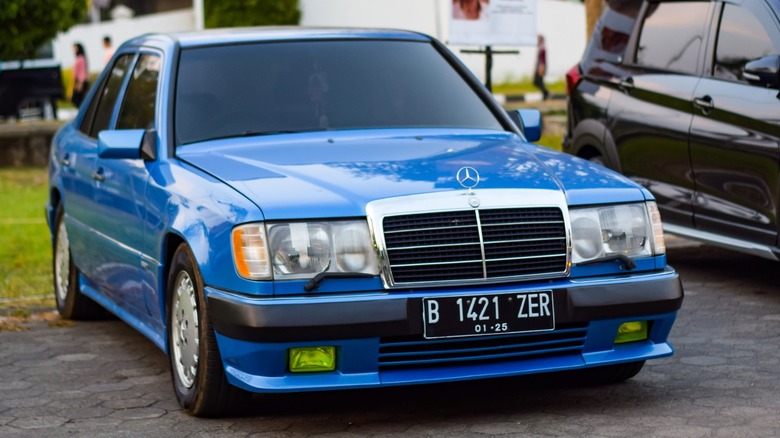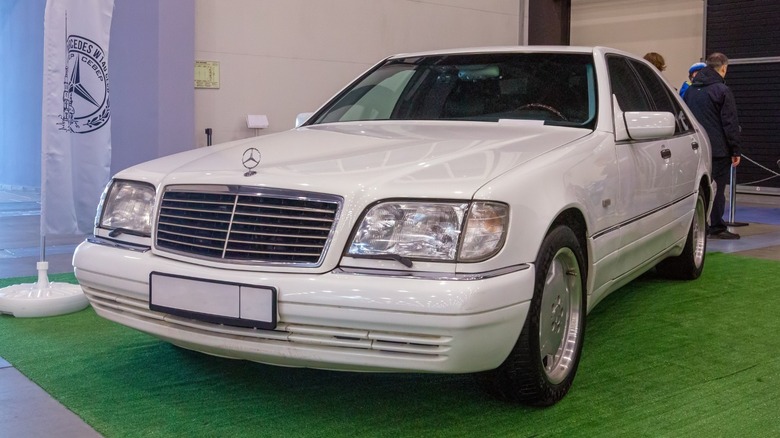BMW and Volkswagen are known for their diesel engines, especially the latter with the infamous «dieselgate» scandal. On the other hand, you’d most likely refer to Mercedes-Benz as a luxury car, and these expensive models typically shy away from rough and noisy diesel engines. However, did you know that the German luxury brand was actually known for its inline-six diesel engine for a time?
This diesel engine is the OM606, which arrived in 1993 and is a three-liter diesel engine, designed to replace the OM617 and OM 603. It had a dual overhead camshaft configuration with four valves per cylinder. It can hit 134 to 174 horsepower and has a 155 to 330 lb-ft of torque.
At just 463 lbs., the OM606 is one of the lightest diesel engines you can get. Some even say that the OM606 is the European diesel version of the legendary Toyota 2JZ engine, which is another three-liter inline-six engine. However, because diesel engines were never popular in the U.S. (with Toyota, one of the most popular brands in the U.S., still not selling a diesel truck), you might be a bit hard-pressed to find a decent example of the OM606.
Nevertheless, enthusiasts who know their way around Mercedes-Benz vehicle would know that the OM606 is one light, reliable, and tunable engine. So, if you’re looking for a classic Mercedes-Benz diesel, you should check out these models that sport the OM606.
Mercedes-Benz W124 E 300

Rakhmat Darmawan/Shutterstock
The Mercedes-Benz W124, made between 1986-1995, was one of the best sedans ever built. When the OM606 became available in 1993, this was one of the first models to receive the new diesel engine. The OM606 engine in this car is only naturally aspirated, so it can deliver 134 horsepower and 155 lb-ft of torque.
Nevertheless, this model is often said to be at the pinnacle of safety, engineering, and innovation, and is supposed to be one of the best cars Mercedes has ever made. Although the E 300 was a lower variant of the E 500 that many enthusiasts love, they still have the same underpinnings, so you can expect the E 300 to have a similar luxurious feel that the high-performance sedan has.
The OM606 was available to the W124 series from 1993 until the end of its run in 1995. However, the following generation of the E-class — the W210 — would also have the OM606 as a diesel engine option.
Mercedes-Benz W210 E 300

Rakhmat Darmawan/Shutterstock
The W210 is the second-generation of the Mercedes-Benz E-class, and is one of the most successful models in Mercedes-Benz history. It also received the OM606 diesel engine as one of its options, but aside from getting the naturally aspirated version, you could also get it with a turbo.
Adding a turbo to the OM606 will bump up engine power from 134 horsepower to 174 horsepower. It also produces 243 lb-ft of torque, giving you a huge bump in performance. One thing you should know about the turbocharged versions of the OM606 is that these motors use sturdier pistons and connecting rods. So, if you have a naturally aspirated OM606, you shouldn’t just bolt on a turbo to it — you might end up seeing a piston punch a hole through your hood.
However, if you already have a turbo OM606, the engine is much beefier. Some tuners say that you can bump its power output up to 500 horsepower without making major changes to the engine internals. This makes the W210 E 300 a great candidate for upgrades, but you must remember that this will likely be an expensive project in the U.S. because of the rarity of parts.
Mercedes-Benz W140 S 300

Oleg Mirabo/Shutterstock
The W140 S 300 is the flagship vehicle of the Mercedes-Benz, and you can also get it with the turbodiesel engine. This shows the quality and reliability of OM606, as Mercedes-Benz engineers felt confident enough to put the engine inside their most expensive sedan.
The OM606 retains the same power output it has in the turbo W210, so it still delivers 174 horsepower and 243 lb-ft of torque. Because the S-class is a larger and heavier beast than the E 300, you should expect it be a bit slower than its smaller brother.
Nevertheless, it can still hit a top speed of 131 mph and has a 0-60 mph time of 10.5 seconds. It’s not the fastest sedan in the world, but it’s still respectable for a 20-year-old car. Furthermore, the S-class is about comfort, rather than speed. If you wanted to go fast, you would’ve taken your Mercedes-AMG SL 43 with you instead.
Mercedes-Benz W463 G 300

Lucky Photographer/Shutterstock
The G-class is one of the most popular SUVs in Mercedes-Benz’s line up, but since it’s also developed for military and utility use, you should expect it to get a diesel engine, too. The W463 G 300 model from 1996-2001 gets the OM606 diesel engine, and it retains the power output you can find on the W140 S 300 and W210 E 300 models.
This means that the G 300 is even slower than these two sedans. But given its high torque output, the engine can then put out where its needed most — when the G 300 goes off-road, as it’s designed to. Besides it relatively high torque, the OM606’s excellent build quality helped make the G-Class one of the most reliable SUVs of all time.
Although many G-Class owners purchased the vehicle for flex and swag, the OM606 gives this SUV excellent utility, too. The W463 can carry a maximum payload of 1,709 lbs., and it can tow up to 1,653 lbs. with an unpowered, unbraked trailer. If your trailer has its own braking system, the engine’s towing capacity jumps to 7,716 lbs. — an impressive number for a vehicle often renowned for its comfortable luxury.
The OM606 has since been replaced by several newer models. Since Volkswagen’s «dieselgate» issue has practically killed the diesel engine in the U.S., we won’t likely see more of these turbodiesels on our roads. Nevertheless, we can celebrate the OM606 and its achievements, allowing us to see the possibilities diesel engines can achieve.